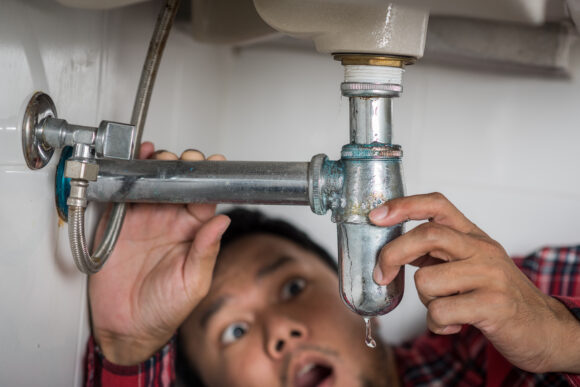I’ve discussed or mentioned water damage claims in several columns this year, from plumbing leaks to widespread geographical flooding. As plumbing systems age, increasingly the number one cause of homeowners claims unrelated to weather involve water leaks. These potential losses can be risk managed in several ways.
For example, there are devices that can detect unusual water flow with regard to gallons per minute or the fact that there is continuous flow, even if tiny.
In the town where I live, the water department began replacing meters last year. The new meters can detect minor continuous flow conditions. These may simply be due to a dripping faucet or shower head, or they may indicate an unseen leak in walls, crawl spaces, etc. Last week, I had my aggregate driveway pressure washed. The next day I got a text message from the city water department that my water usage was unusually high.
This technology effectively applies the risk management technique of loss control to potential water damage claims. Either it prevents serious damage via early detection, or it reduces loss that has already been occurring.
Loss control is almost always a better risk management approach than after-the-fact insurance. That’s particularly true given how many property policies exclude damage arising from repeated seepage and leakage, along with almost inevitable fungus infections for which there is no or limited coverage even when water damage is sudden and unexpected.
This brings me to the focus of this article, understanding that not all repeated seepage and leakage claims are or must be completely excluded.
First of all, ISO’s HO 00 03 homeowners policy has no “repeated seepage or leakage” exclusion and hasn’t for the past 30 years. Many, if not most, non-ISO insurers have such an exclusion in their policy and many ISO carriers attach their own exclusionary endorsement to the ISO policy. Some of these exclusions have exceptions for hidden damage, which is effectively how ISO views this. ISO’s HO 00 03 form relies on the Neglect exclusion — as long as discovered hidden damage is reported promptly, it’s covered.
In my case, I’ve had three personal lines carriers on the home where we’ve lived for the past 10-plus years. Of the three insurers, one did not have this exclusion and the other two did. So, it’s possible that coverage may be placed without a “repeated seepage or leakage” exclusion or perhaps such an exclusion, especially if added by endorsement, could be negotiated off the policy, even if a premium is attached to the broadened coverage.
Second, not all legal jurisdictions have applied a “repeated seepage or leakage” type exclusion absolutely. Often these exclusions reference some sort of time frame, for example, “14 days or more” or “weeks, months, or years.”
As reported earlier this year in the Merlin Law Group’s Property Insurance Coverage Law Blog, in Hicks v. American Integrity Ins. Co. of Florida, 241 So.3d 925 (Fla. 5th 2018), the court opined:
“In light of the general principle that insurance policy provisions susceptible to more than one interpretation should be construed liberally in favor of the insured and strictly against an insurer, and that exclusionary clauses should be read even more narrowly, we hold that an insurance policy excluding losses caused by constant or repeated leakage or seepage over a period of 14 days or more does not unambiguously exclude losses caused by leakage or seepage over a period of 13 days or less.”
Third, plumbing leak claim denials may be based on faulty policy language interpretations. This can be true even when such damage is sudden and does not occur over a long period of time.
For example, a water line fitting underneath a commercial building in Virginia burst, causing water to seep within minutes or hours through the floor. The carrier denied the claim, citing the Water Damage exclusion for “Water under the ground surface pressing on, or flowing or seeping through (a) Foundations, walls, floors or paved surfaces; (b) Basements, whether paved or not; or (c) Doors, windows or other openings …”
When viewed historically and in the context of the other types of excluded damage in the Water Damage exclusion, clearly this provision was not designed to exclude water damage arising from a burst plumbing line, whether it occurs within the building or beneath it. Read in its entirety, the policy in question clearly covers virtually any sudden and accidental plumbing leak other than an underground pipe outside the building.
For the majority of buildings, water enters through underground pipes.As I’ve written before, I believe the “underground” language in the Water Damage exclusion is meant to apply to rising water tables, rainfall saturated earth, underground aquifers, etc., not plumbing leaks.
Within a week of the aforementioned claim, an almost identical claim was brought to my attention involving an Arizona building.
A water line underneath the floor burst and the insurer cited the same “underground water” provision in the Water Damage exclusion.
This claim involved the ISO CP 10 30 12 special causes of loss form, which defines water damage on the last page, including this concluding paragraph:
“To the extent that accidental discharge or leakage of water falls within the criteria set forth in c.(1) or c.(2) of this definition of “specified causes of loss,” such water is not subject to the provisions of the Water Damage Exclusion which preclude coverage for surface water or water under the surface of the ground.”
This illustrates an important concept when reading and interpreting insurance contracts. The principle of “entirety of contract” requires that the entire policy be reviewed. Sometimes an exclusion appears to be complete and absolute until you continue reading the policy and find an exception or coverage otherwise to the contrary.
As I always say, “RTFP!”
Was this article valuable?
Here are more articles you may enjoy.



 MAPFRE Accuses AAA of Violating Long-Time Exclusive Marketing Agreement
MAPFRE Accuses AAA of Violating Long-Time Exclusive Marketing Agreement  Longtime Motel 6 Spokesman Tom Bodett Settles Lawsuit Against Chain
Longtime Motel 6 Spokesman Tom Bodett Settles Lawsuit Against Chain  CRC Group Signs Agreement to Acquire Euclid Transactional
CRC Group Signs Agreement to Acquire Euclid Transactional  Disney Worker Injured Trying to Stop Runaway Boulder at Indiana Jones Show
Disney Worker Injured Trying to Stop Runaway Boulder at Indiana Jones Show 



